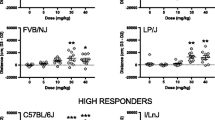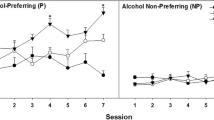Abstract
This study investigated the influence of genetics on extent of cocaine taking in rats that were self-administering cocaine under a progressive-ratio schedule. Fischer 344, ACI and Brown Norway rats were subjects because previous genetic studies on dopamine receptor loci have indicated that these are genetically divergent strains. All subjects were assessed for acquisition and stability of cocaine self-administration under a progressive-ratio schedule. Subsequently, a dose-effect curve for cocaine self-administration was determined for each strain. Fischer 344 rats maintained a higher average breaking point than did the ACI or Brown Norway strains. In addition, dopamine receptor antagonists differentially reduced the ability of cocaine to serve as a reinforcer across the three strains. The D1-selective dopamine receptor antagonist, SCH 23390, and the D2/D3-selective dopamine receptor antagonist, eticlopride, were significantly more effective in reducing the self-administration of cocaine in Brown Norway rats than for the other two strains. The results of this study demonstrate that genetic differences may play an important role in determining responding under progressive-ratio schedules for cocaine, possibly due to differences in the reinforcing efficacy of cocaine.
Similar content being viewed by others
References
Aigner TG, Balster RL (1978) Choice behavior in rhesus monkeys: cocaine versus food. Science 201:534–535
Cadoret RJ, O'Gorman T, Troiughton E, Heywood E (1986) An adoption study of genetic and environmental factors in drug abuse. Arch Gen Psychiatry 43:1131–1136
Carmelli D, Swan GE, Robinette D, Fabsitz RR (1990) Heritability of substance use in the NAS-NRC twin registry. Acta Genet Med Gemenol 39:91–98
Carney JM, Cheng M-S, Cao W, Seale TW (1991) Issues surrounding the assessment of the genetic determinants of drugs as reinforcing stimuli. J Addict Dis 10:163–177
Carroll ME, France CP, Meisch RA (1979) Food deprivation increases oral and intravenous drug intake in rats. Science 205:319–321
Crabbe JC, Belknap JK, Buck KJ (1994) Genetic animal models of alcohol and drug abuse. Science 264:1715–1723
Depoortere RY, Li D-H, Lane, JD, Emmett-Oglesby MW (1993) Parameters of self-administration of cocaine in rats under a progressive ratio schedule. Pharmacol Biochem Behav 45:539–548
de Wit H, Wise RA (1977) Blockade of cocaine reinforcement in rats with the dopamine receptor blocker pimozide but not with the noradrenergic blocker phentolamine or phenoxybenzamine. Can J Psychol 31:195–203
de Wit H, Uhlenhuth EH, Johanson CE (1986) Individual differences in the reinforcing and subjective effects of amphetamine and diazepam. Drug Alcohol Depend 16:341–360
Elmer GI, Meisch RA, Goldberg SR, George FR (1990) Ethanol self-administration in Long Sleep and Short Sleep mice: evidence for genetic independence of neurosensitivity and reinforcement. J Pharmacol Exp Ther 254:1054–1062
Emmett-Oglesby MW, Lane JD (1992) Tolerance to the reinforcing effects of cocaine. Behav Pharmacol 3:193–200
Essman WD, Luedtke RR, McGonigle P, Lucki I (1995) Variations in the behavioral response to apomorphine in different strains of rats. Behav Pharmacol 6:2–15
George FR (1991) Is there a common biological basis for reinforcement from alcohol and other drugs? J Addict Dis 10:127–139
George FR, Goldberg SR (1988) Genetic factors in response to cocaine. Natl Inst Drug Abuse Monogr 88:239–249
Griffiths RR, Brady JV, Snell JD (1978) Progressive-ratio performance maintained by drug infusions: comparison of cocaine, diethylpropion, chlorphentermine, and fenfluramine. Psychopharmacology 56:5–13
Griffiths RR, Bigelow GE, Henningfield JE (1980) Similarities in animal and human drug-taking behavior. In: Mello NK (ed) Advances in substance abuse, vol. 1. JAI Press, Greenwich, Conn., pp 1–90
Guitart X, Beitner JD, Marby DW, Kosten TA, Nestler EJ (1992) Fischer and Lewis rats strains differ in basal levels of neurofilament proteins and their regulation by chronic morphine in the mesolimbic dopamine system. Synapse 12:242–253
Heath AC, Meyer J, Eaves LJ, Martin NG (1991) The inheritance of alcohol consumption patterns in a general population twins sample: multidimensional scaling of quantity/frequency data. J Stud Alcohol 52:345–351
Hodos W (1961) Progressive-ratio as a measure of reward strength. Science 134:943–944
Howell LL, Byrd LD (1991) Characterization of the effects of cocaine and GBR-12909, a dopamine uptake inhibitor, on behavior in the squirrel-monkey. J Pharmacol Exp Ther 258:178–185
Hubner CB, Moreton JE (1991) Effects of selective D1 and D2 dopamine antagonists on cocaine self-administration in the rat. Psychopharmacology 105:151–156
Iwamoto ME, Martin W (1988) A critique of drug self-administration as a method for predicting abuse potential of drugs. In: Harris LS (ed) Problems of drug dependence. US Government Printing Office, Washington DC, pp 457–465
Johanson CE, Balster RL (1978) A summary of the results of a drug self-administration study using substitution procedures in rhesus monkeys. Pharmacol Biochem Behav 4:45–51
Johanson CE, Fischman MW (1989) The pharmacology of cocaine related to its abuse. Pharmacol Rev 41:3–52
Katz JL (1990) Models of relative reinforcing efficacy of drugs and their predictive utility. Behav Pharmacol 1:283–301
Koob GF, Bloom FE (1988) Cellular and molecular mechanisms of drug dependence. Science 242:715–723
Koob GF, Le H, Creese I (1987) The D1 dopamine receptor antagonist SCH 23390 increases cocaine self-administration in the rat. Neurosci Lett 79:315–320
Kosten TA, Miserendino MJD, Chi S, Nestler EJ (1994) Fischer and Lewis rat strains show differential cocaine effects in conditioned place preference and behavioral sensitization but not in locomotor activity or conditioned taste aversion. J Pharmacol Exp Ther 269:137–144
Meisch RA, Lemaire GA (1993) Drug self-administration. In: Van Haaren F (ed) Methods in behavioral pharmacology. Elsevier, New York, pp 257–300
Merikangas KR (1990) The genetic epidemiology of alcoholism. Psychol Med 20:11–22
Mirin SM, Weiss RD, Griffin ML, Michael JL (1991) Psychopathology in drug abusers and their families. Comp Psychiatry 32:36–51
Moss HB, Yao JK, Maddock JM (1989) Responses by sons of alcoholic fathers to alcoholic and placebo drinks: perceived mood, intoxication, and plasma prolactin. Alcohol Clin Exp Res 13:252–257
Risner ME, Silcox DL (1981) Psychostimulant self-administration by beagle dogs in a progressive-ratio paradigm. Psychopharmacology 75:25–30
Roberts DCS (1989) Breaking points on a progressive-ratio schedule reinforced by intravenous apomorphine increase daily following 6-hydroxydopamine lesions of the nucleus accumbens. Pharmacol Biochem Behav 32:43–47
Roberts DCS, Vickers GJ (1984) Atypical neuroleptics increase self-administration of cocaine: an evaluation of a behavioral screen for antipsychotic activity. Psychopharmacology 81:135–139
Rounsaville BJ, Kosten TR, Weissman MM, Prusoff B, Pauls DL, Anton SF, Merikangas K (1991) Psychiatric disorders in relatives of probands with opiate addiction. Arch Gen Psychiatry 48:33–42
Scott AW, Griffin SA, Luedtke RR (1995) Genetic polymorphisms at the rat and murine loci coding for dopamine D2-like receptors. Mol Brain Res 29:347–357
Spencer DG Jr, Emmett-Oglesby MW (1985) Parallel processing strategies in the application of microcomputers to the behavioral laboratory. Behav Res Meth Instr Comp 17:294–300
Suzuki T, Funada M, Narita M, Misawa M, Nagase H (1993) Morphine-induced place preference in the CXBK mouse: characteristics of mu opioid receptor subtypes. Brain Res 602:45–52
Uhl GR, Blum K, Smith SS (1993) Substance abuse vulnerability and D2 receptor genes. Trends Neurol Sci 16:83–88
Waller MB, McBride WJ, Gatto GJ, Lumeng L, Li T-K (1984) Intragastric self-infusion of ethanol by ethanol-preferring and non-preferring lines of rats. Science 225:78–80
Wilkinson L (1990) SYSTAT: the system for statistics. SYSTAT, Evanston, Ill.
Woolverton WL (1986) Effects of a D1 and a D2 dopamine antagonist on the self-administration of cocaine and piribedil by rhesus monkeys. Pharmacol Biochem Behav 24:531–535
Woolverton WL, Virus RM (1989) The effects of a D1 and a D2 antagonist on behavior maintained by cocaine or food. Pharmacol Biochem Behav 32:691–698
Author information
Authors and Affiliations
Additional information
These experiments were conducted in accordance with “Principles of laboratory animal care” (NIH publication No. 85-23, revised 1985)
Rights and permissions
About this article
Cite this article
Ward, A.S., Li, D.H., Luedtke, R.R. et al. Variations in cocaine self-administration by inbred rat strains under a progressive-ratio schedule. Psychopharmacology 127, 204–212 (1996). https://doi.org/10.1007/BF02246128
Received:
Revised:
Issue Date:
DOI: https://doi.org/10.1007/BF02246128




